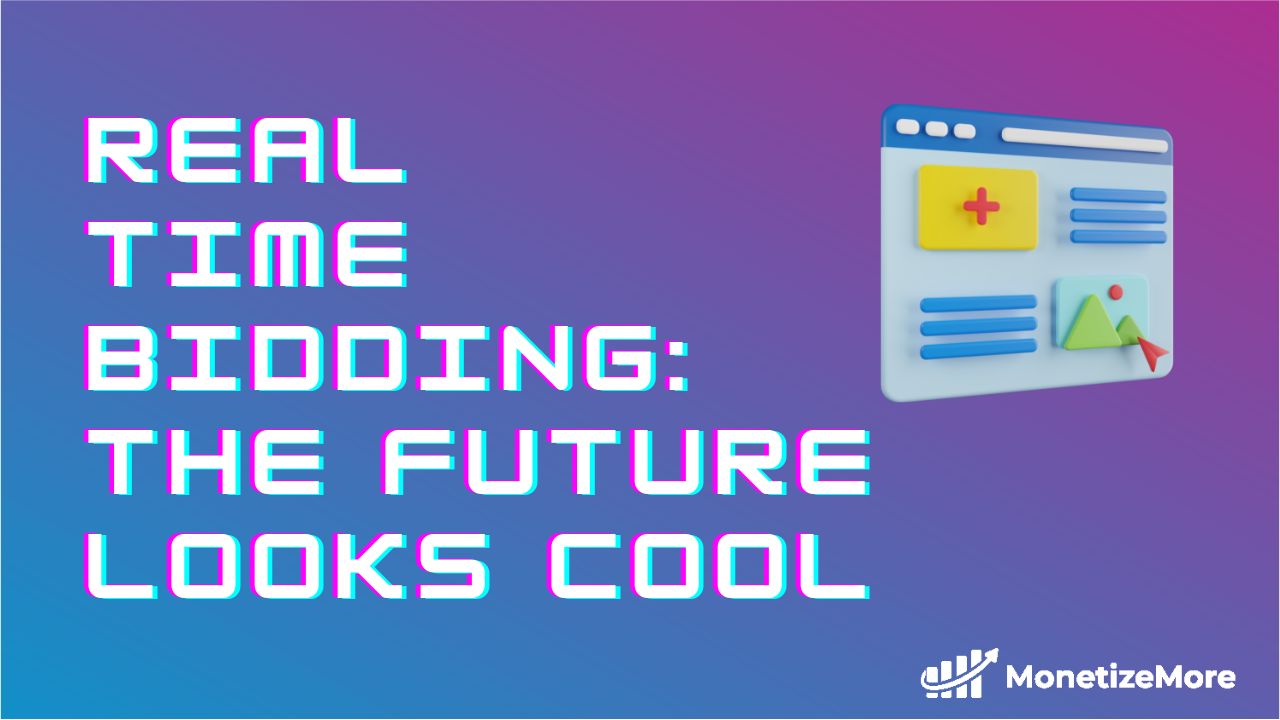
This post was most recently updated on March 19th, 2024
Real-time bidding (RTB) is an automated digital auction process where advertisers bid on ad impressions in milliseconds, as a webpage is loading. This allows publishers to sell ad space to the highest bidder instantly, maximizing the value of each impression.
Understanding Real-Time Bidding (RTB) can significantly impact your bottom line as a publisher. RTB networks have become a vital component of programmatic advertising with the potential to generate billions of dollars annually. In this guide, we’ll explore everything you need to know about RTB, including how it works, the benefits it offers publishers, and how you can maximize your revenue through effective RTB strategies.
Whether you’re new to RTB or looking to take your programmatic advertising to the next level, this guide will provide valuable insights to help you succeed in the ever-growing digital advertising landscape.
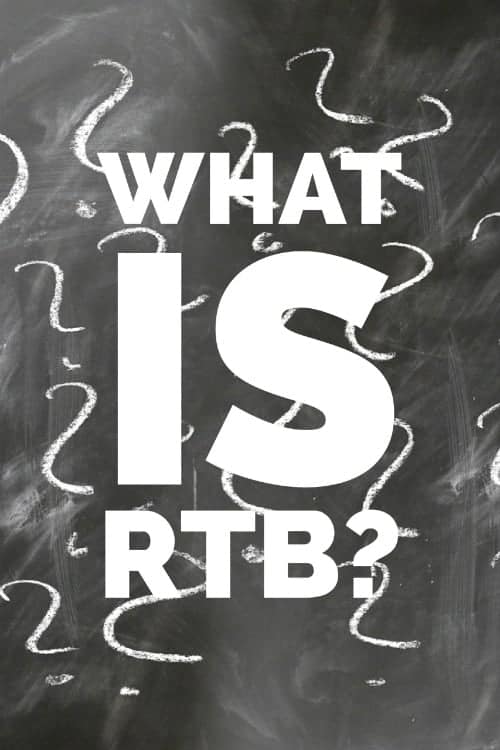
Before we get into the details, I’d like to explain RTB and how it works. This will give you a better understanding of the processes and platforms discussed in this article.
If this is your first time discovering programmatic advertising, be sure to take a moment to read our Programmatic Advertising For Dummies article here to get some background information on this tech-driven advertising industry.
Real Time Bidding is an auction setting where ad impressions are sold and bought, and transactions occur within seconds. Once an advertiser’s bid wins the auction, their digital ad is instantaneously shown on the website or property of the publisher. Supporting platforms such as Ad Exchanges and Supply Side Platforms are also used within the process. RTB auctions put the focus on impression-based bidding, whereas static auctions tend to group impressions, only allowing advertisers to bid on them in package deals.
When a user visits a website, a corresponding bid request is sent to an Ad Exchange.
This bid request then contains different types of information such as demographical data, location information, browser history, etc. The Ad exchange then passes the bid requests along to its list of advertisers/buyers who bid in real-time for the ad impression as it gets presented to the website user. The advertiser that bids the highest amount wins the impression and gets its ad served in front of the site user.
This same process gets repeated time and time for every ad unit of the website property page. This procedure occurs within 100 milliseconds, including receiving the bid request and serving the ad. Talk about creating an efficient advertising ecosystem!
Take a look at this infographic from Whoishostingthis.com to get an oversight of the RTB process.

Source: http://marketingland.com/infographic-real-time-bidding-83186
Here’s a table comparing Real-Time Bidding (RTB) and Programmatic Advertising:
| Real-Time Bidding (RTB) | Programmatic Advertising | |
|---|---|---|
| Definition | An auction-based system for buying/selling ad impressions in real-time, where advertisers bid on ad impressions in milliseconds | An automated way of buying/selling ad inventory, leveraging data and algorithms to target specific audiences |
| Process | Auction-based bidding in real-time | Automated buying and selling based on algorithms and data |
| Ad Inventory | Purchases specific ad impressions | Purchases ad inventory in bulk |
| Targeting | Granular targeting based on real-time data | Automated targeting based on audience profiles |
| Cost | Bidding system determines ad price | Automated bidding and price determination based on data |
| Efficiency | Efficient use of ad spend | Streamlined buying and selling of ad inventory |
| Scale | Large-scale ad campaigns | Large-scale ad campaigns |
| Benefits | Highly targeted ads and cost efficiency | Automated buying/selling and audience targeting |
Overall, both Real-Time Bidding and Programmatic Advertising offer benefits such as efficient use of ad spend, streamlined buying and selling of ad inventory, and large-scale ad campaigns. However, RTB is more focused on real-time auction-based bidding, whereas programmatic advertising leverages data and algorithms to automate the buying and selling of ad inventory.
RTB offers granular targeting based on real-time data, while programmatic advertising relies on automated targeting based on audience profiles. Ultimately, the choice between RTB and programmatic advertising depends on the advertiser’s goals and the specific needs of their campaign.
Similarly to the previous explanation, Real Time Bidding ads, and Ad Exchanges are not the same. Ad Exchanges play a significant role within Programmatic advertising and is a vital cog in the RTB machine as shown in the image below from the IAB (Interactive Advertising Bureau). As mentioned earlier, this image will help provide oversight into the Programmatic advertising ecosystem.
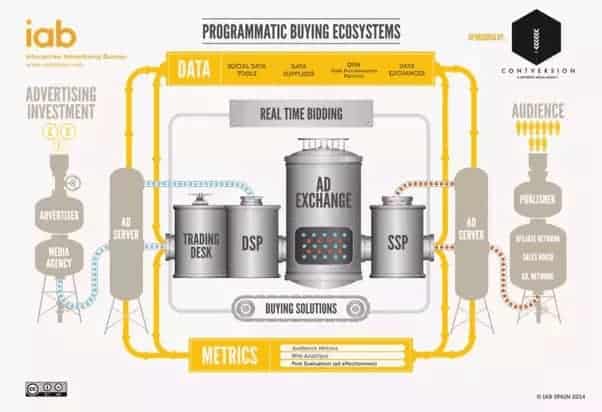
As demonstrated, in the process of ad inventory being bought and sold on a per-impression basis, Ad Exchanges act as the platform where publishers and advertisers come together to trade digital ad inventory
This marketplace (Ad Exchange) uses DSPs (Demand side platforms) to assess the ad inventory available to the advertisers. If the impression is found to match the advertiser’s target audience, a bid is placed via the DSP, and if won, the ad gets delivered to the publisher’s website.
Here’s a table comparing Real-Time Bidding (RTB) and Demand Side Platforms (DSPs):
| Real-Time Bidding (RTB) | Demand Side Platforms (DSPs) | |
|---|---|---|
| Definition | An auction-based system for buying/selling ad impressions in real-time, where advertisers bid on ad impressions in milliseconds | A platform that helps advertisers automate the process of buying ad inventory from multiple sources |
| Process | Auction-based bidding in real-time | Automated buying from multiple sources based on algorithms and data |
| Ad Inventory | Purchases specific ad impressions | Purchases ad inventory in bulk from multiple sources |
| Targeting | Granular targeting based on real-time data | Automated targeting based on audience profiles |
| Integration | Typically integrated with Supply Side Platforms (SSPs) or ad exchanges | Integrates with multiple ad exchanges and SSPs |
| Cost | Bidding system determines ad price | Automated bidding and price determination based on data |
| Efficiency | Efficient use of ad spend | Streamlined buying and selling of ad inventory |
| Scale | Large-scale ad campaigns | Large-scale ad campaigns |
| Benefits | Highly targeted ads and cost efficiency | Automated buying/selling, audience targeting, and optimization of ad spend |
Overall, both Real-Time Bidding and Demand Side Platforms offer benefits such as efficient use of ad spend, streamlined buying and selling of ad inventory, and large-scale ad campaigns.
However, RTB focuses more on real-time auction-based bidding, whereas DSPs automate buying ad inventory from multiple sources. RTB offers granular targeting based on real-time data, while DSPs rely on automated targeting based on audience profiles. RTB is typically integrated with Supply Side Platforms (SSPs) or ad exchanges, whereas DSPs integrate with multiple ad exchanges and SSPs. Ultimately, the choice between RTB and DSPs depends on the advertiser’s goals, the specific needs of their campaign, and their preferred approach to buying ad inventory.
Real-time bidding (RTB) plays a crucial role within the Programmatic Open Exchange by facilitating live auctions to dictate the costs for available ad spaces dynamically. This real-time auction system lets bidders to actively compete with each other on who gets to display their ads. Through RTB, the highest bidder secures the ad impressions, ensuring a fair and competitive environment for all participants in the open exchange.
The Programmatic Open Exchange serves as a virtual marketplace where ad inventory is bought and sold in an open setting. It’s where publishers put their ad inventory (website banners, video ad slots, etc.) up for sale. Advertisers then come in looking to buy this inventory to display their ads. The whole process is automated through technology platforms—no manual negotiations are needed.
Unlike private marketplaces, anyone can participate. Publishers can list their inventory, and advertisers of all sizes can bid on it.
The magic lies in real-time bidding (RTB):
RTB (Real-Time Bidding) and Header Bidding have a close, even intertwined relationship in the sense that header bidding is a more advanced way to conduct Real-Time Bidding.
It’s the cherry on top of RTB that makes it easier for publishers to get the best possible price for their ad inventory.
Header Bidding allows publishers to simultaneously offer their ad inventory to multiple ad exchanges and demand sources before the primary ad server’s actual ad call. This process optimizes the RTB mechanism by increasing competition and potentially generating higher revenues for publishers.
RTB, as a subset of programmatic advertising, involves the automated buying and selling of ad impressions in real-time auctions while Header Bidding, which is a subset of RTB, facilitates a more transparent and competitive ad inventory auction process for publishers.
While Header Bidding enhances RTB, it is not the only subset of RTB. Similarly, RTB is not the only subset of programmatic advertising. Programmatic advertising involves a whole suite of technologies and processes, including DSPs, SSPs, data management platforms, etc.
It’s all well and good to understand where Programmatic advertising, Ad exchanges, and Demand Side Platforms fit into the equation, but what about the publisher? Does RTB benefit the publisher in any way? Econsultancy.com identified six benefits for the publisher which include:
Technology-driven accurate pricing: Publishers receive more value for their inventory with RTB as each impression can be bid on by advertisers and precisely the highest bid amount can deliver the impression. A publisher frequently needs to use an SSP (Supply Side Platform) to make use of Real Time Bidding.
Remnant inventory value increase: As a publisher, you want to monetize as much of your inventory as possible. With RTB, inventory that was previously deemed non-monetized or not worthy can be utilized by advertisers who bid based on the audience data. Econsultancy reported that over 40% of publishers saw an increase in the value of their remnant inventory when taking part in RTB auctions.
Control via SSPs: As mentioned, a publisher needs to work through a Supply Side Platform to take part in RTB auctions. However, this means that the publisher has added control over their inventory such as specifying which advertisers can buy their ad inventory and set the pricing.
Understanding their audience better: As a publisher, it’s often hard to know which segment of your audience deserves the most attention, at least from a monetary perspective. Using this technology publishers can determine which types of audiences interests advertisers the most and fetches the best prices. This can give a publisher valuable insight and help them expand their websites into their most profitable segments, ultimately increasing their inventory value and increasing demand from advertisers.
Premium publishers use private marketplaces: With private markets, only a set group of advertisers can bid on a publisher’s ad inventory. With RTB and private marketplaces, publishers can sell their advertising stock with even more transparency and control.
Better performing direct sales: If a publisher wants to sell his inventory directly to advertisers working through SSPs, then Real Time Bidding can give them valuable insight into their most profitable inventory segments. A publisher can determine what parts are sought after the most, and the prices their ad inventory is sold at and uses this information to sell their inventory directly to interested parties successfully.
From the perspective of buyers/advertisers Econsultancy.com describes it as a form of PPC or pay-per-click marketing. Most companies or advertisers who have tried to market a product or service online will be familiar with that term. Advertising via Facebook or Google AdWords is a good example of PPC.
With this short introduction in mind, here are four benefits of RTB for buying display advertising:
Less wasteful media buying: With this technology ad inventory is bought on an impression basis through a range of variables which makes targeting very focused. An advertiser does not have to buy ad inventory in bulk and risk wasting money on untargeted or irrelevant website visitors. Advanced techniques and tools such as frequency capping and bid forecasting can further increase the efficiency of each campaign by allowing advertisers to test, control, evaluate, and even predict certain campaign variables.
Campaigns with Improved ROI: Advertisers can view and manage their campaigns in real-time through one dashboard and adjust bids and targeting as needed, thus staying on top of results and improving performance.
In-depth knowledge: Advertisers can transform and improve their marketing strategies while running campaigns with RTB. They can learn more and grow to understand their consumers, as well as use creative and strategic approaches with the impression data presented to them through their campaigns.
Brand protection: Protecting an advertiser’s brand is very important. With Real-Time Bidding, advertisers can specify where to promote their products or services and use ad verification services to prevent their ads from showing on illicit websites or pages.
While RTB has revolutionized online advertising, you need to be aware of its potential drawbacks like:
Many of these drawbacks have solutions or mitigation strategies:
The future of Real-Time Bidding (RTB) in the adtech industry looks promising. With the increasing demand for programmatic advertising and the rise of digital ad spending, RTB is expected to grow exponentially in the coming years.
Recent studies have projected that the RTB industry will reach a market value of over $50 billion by 2028.
Artificial Intelligence (AI) and Machine Learning (ML) in RTB are also expected to improve ad targeting, leading to higher conversion rates and ROI for advertisers. Furthermore, integrating RTB with other ad tech technologies like Header Bidding and Programmatic Direct will enhance its capabilities and drive its adoption. As the ad tech industry continues to evolve and innovate, RTB is set to remain a key player in the programmatic advertising landscape.
The potential for RTB optimization with AI is huge! To unlock that potential, an RTB expert is necessary. Sign up for a Professional account at MonetizeMore today!

With over ten years at the forefront of programmatic advertising, Aleesha Jacob is a renowned Ad-Tech expert, blending innovative strategies with cutting-edge technology. Her insights have reshaped programmatic advertising, leading to groundbreaking campaigns and 10X ROI increases for publishers and global brands. She believes in setting new standards in dynamic ad targeting and optimization.
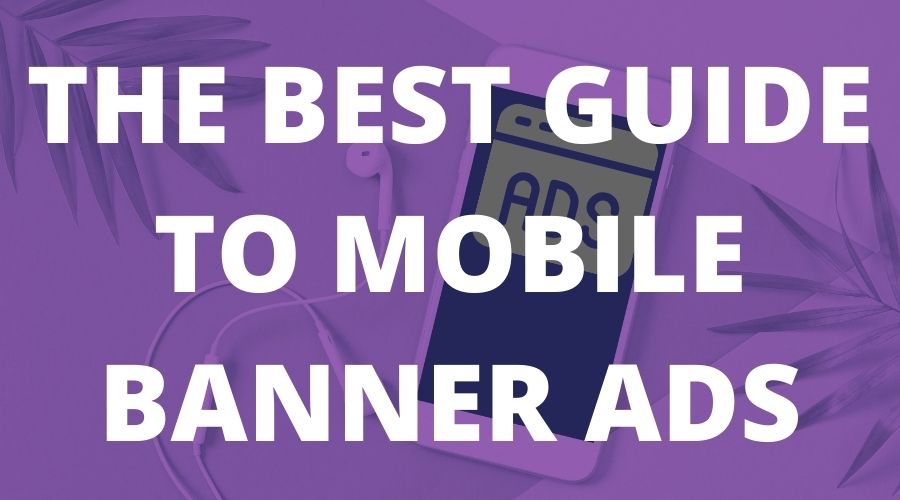

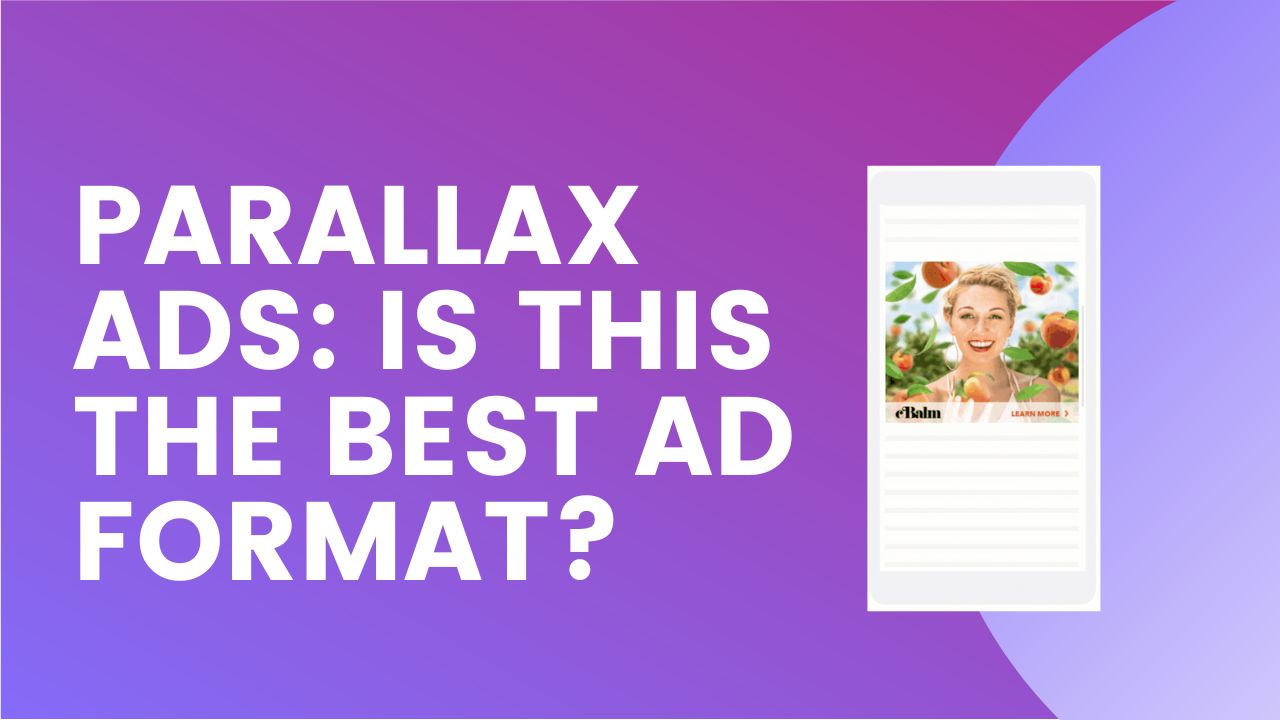
10X your ad revenue with our award-winning solutions.